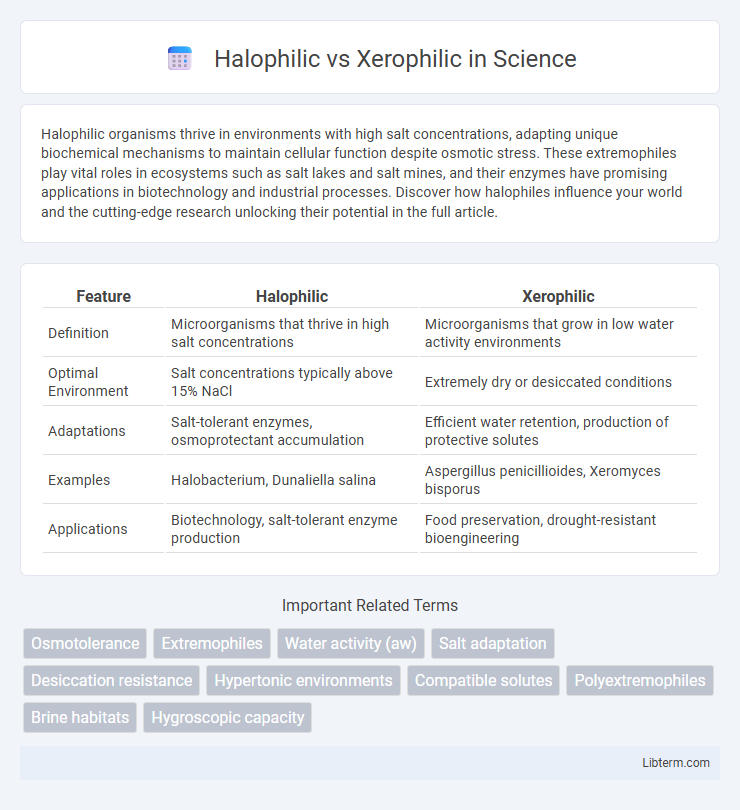Halophilic organisms thrive in environments with high salt concentrations, adapting unique biochemical mechanisms to maintain cellular function despite osmotic stress. These extremophiles play vital roles in ecosystems such as salt lakes and salt mines, and their enzymes have promising applications in biotechnology and industrial processes. Discover how halophiles influence your world and the cutting-edge research unlocking their potential in the full article.
Table of Comparison
| Feature | Halophilic | Xerophilic |
|---|---|---|
| Definition | Microorganisms that thrive in high salt concentrations | Microorganisms that grow in low water activity environments |
| Optimal Environment | Salt concentrations typically above 15% NaCl | Extremely dry or desiccated conditions |
| Adaptations | Salt-tolerant enzymes, osmoprotectant accumulation | Efficient water retention, production of protective solutes |
| Examples | Halobacterium, Dunaliella salina | Aspergillus penicillioides, Xeromyces bisporus |
| Applications | Biotechnology, salt-tolerant enzyme production | Food preservation, drought-resistant bioengineering |
Introduction to Halophilic and Xerophilic Organisms
Halophilic organisms thrive in high-salt environments such as salt lakes, saline soils, and marine habitats, exhibiting specialized adaptations to maintain osmotic balance. Xerophilic organisms survive and grow in extremely dry conditions, often found in deserts or dried foods, by managing water retention and cellular stability. Both groups demonstrate unique physiological and biochemical mechanisms enabling resilience in their respective extreme habitats.
Defining Halophiles: Salt-Loving Microbes
Halophiles are salt-loving microbes thriving in environments with extremely high salt concentrations, such as salt flats, saline lakes, and salt mines. These microorganisms have specialized adaptations, including salt-in strategies and compatible solutes, allowing them to maintain cellular function and osmotic balance in hypersaline conditions. Halophiles contrast with xerophiles, which are adapted to survive in arid, dry environments rather than saline habitats.
Understanding Xerophiles: Masters of Dryness
Xerophiles are microorganisms that thrive in extremely dry environments by efficiently retaining water and stabilizing cellular structures under desiccation stress. These organisms produce protective compounds like trehalose and accumulate compatible solutes to maintain osmotic balance and prevent protein denaturation. Unlike halophiles, which adapt to high salt concentrations, xerophiles specialize in enduring low-moisture conditions essential for their survival in arid habitats and dried food products.
Key Environmental Differences: Salt vs. Dry
Halophilic organisms thrive in environments with high salt concentrations, often found in salt lakes, saline soils, and saltwater bodies, where osmotic pressure is a critical survival factor. Xerophilic organisms adapt to extremely dry conditions, inhabiting arid deserts, dried foods, and low-moisture habitats, where water scarcity is the primary challenge. The key environmental difference lies in halophiles' ability to tolerate and utilize saline environments, whereas xerophiles specialize in enduring minimal water availability.
Unique Adaptation Mechanisms
Halophilic organisms thrive in high-salinity environments by accumulating compatible solutes like potassium ions to maintain osmotic balance and stabilize proteins against salt-induced denaturation. Xerophilic species exhibit remarkable adaptations such as producing extracellular polysaccharides and possessing highly efficient water retention systems to survive extreme desiccation. These unique mechanisms enable halophiles and xerophiles to colonize niches inhospitable to most life forms, showcasing evolutionary specialization for salt and water scarcity tolerance.
Ecological Niches and Habitats
Halophilic organisms thrive in high-salt environments such as salt lakes, saline soils, and salt mines, where sodium chloride concentration can reach extreme levels. Xerophilic species are adapted to survive in dry habitats like deserts, dry soils, and arid regions, enduring minimal water availability and intense desiccation stress. These distinct ecological niches reflect specialized physiological mechanisms; halophiles maintain osmotic balance through compatible solutes, while xerophiles optimize water retention and cellular repair under drought conditions.
Industrial and Biotechnological Applications
Halophilic microorganisms, thriving in high-salt environments, are exploited for biotechnological applications such as enzyme production, bioremediation of saline wastewaters, and biosynthesis of compatible solutes like ectoine used in cosmetics and pharmaceuticals. Xerophilic microbes, adapted to low-water-activity environments, are valuable in industrial processes involving dry or high-osmotic conditions, including bio-preservation, production of dehydrated foods, and development of drought-resistant enzymes for biocatalysis. Both extremophiles contribute novel biochemical pathways and robust biomolecules, enabling innovative solutions in sectors demanding stability under extreme salinity or desiccation.
Challenges in Cultivation and Study
Halophilic microorganisms require high salt concentrations, making their cultivation challenging due to the need for specialized media and equipment resistant to corrosion and osmotic stress. Xerophilic organisms thrive in extremely dry environments, complicating their study by demanding precise humidity control and prevention of contamination during low-moisture cultivation. Both types present obstacles in laboratory replication of natural habitats, necessitating advanced techniques to accurately simulate environmental conditions and maintain viability for research.
Halophiles vs. Xerophiles: Comparative Insights
Halophiles thrive in high-salt environments, utilizing specialized cellular mechanisms such as compatible solutes and salt-in strategies to maintain osmotic balance, whereas xerophiles adapt to extreme dryness by minimizing water loss through protective biofilms and efficient water retention systems. Both organisms exhibit unique gene expressions that optimize survival under environmental stress, yet halophiles rely on ionic regulation, and xerophiles emphasize desiccation resistance. Understanding these adaptations provides critical insights into extremophile biodiversity and potential biotechnological applications in salt- and drought-prone environments.
Future Research Directions and Opportunities
Future research on halophilic and xerophilic microorganisms should explore genetic adaptations that enable survival in extreme salinity and desiccation, unlocking potential applications in biotechnology and agriculture. Investigating metabolic pathways and stress response mechanisms can lead to innovations in bioengineering for enhanced stress tolerance in crops and industrial enzymes. Emerging omics technologies and synthetic biology offer opportunities to harness these extremophiles for sustainable solutions in climate resilience and bioremediation.
Halophilic Infographic

 libterm.com
libterm.com